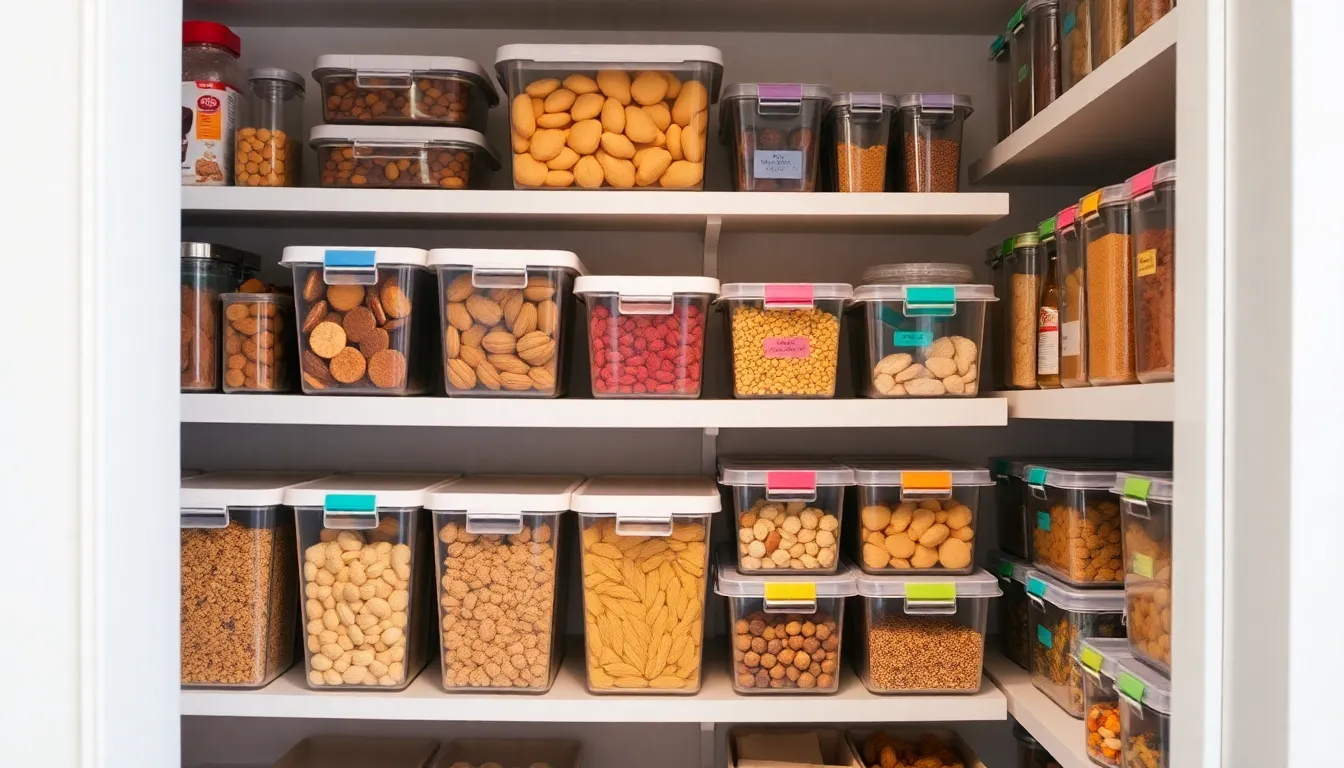Table of Contents
ToggleA well-organized pantry can transform the way one approaches meal prep and grocery shopping. It’s more than just a storage space; it’s a hub of creativity and efficiency in the kitchen. With the right system in place, anyone can save time, reduce food waste, and even inspire healthier eating habits.
In today’s fast-paced world, clutter can quickly accumulate, making it hard to find what’s needed. By implementing effective pantry organization strategies, individuals can create a functional and inviting space that enhances their cooking experience. Discovering simple tips and tricks can lead to a pantry that not only looks great but also works seamlessly for everyday needs.
Benefits Of Pantry Organization
A well-organized pantry enhances not only the efficiency of meal preparation but also contributes to better food management. It simplifies grocery shopping, streamlines cooking processes, and supports healthier eating.
Increased Efficiency
Increased efficiency results from a systematic pantry layout. Arranging items by category—grains, canned goods, spices, and snacks—allows quick access to ingredients. Labeling shelves and containers boosts visibility of supplies, reducing time spent searching. Storing frequently used items at eye level encourages daily cooking, promoting a consistent meal preparation routine.
Improved Food Preservation
Improved food preservation occurs through organized storage practices. Using clear, airtight containers extends the shelf life of dry goods, while categorizing perishables minimizes spoilage. An organized pantry aids in inventory management, helping to identify expired items and reduce waste. By maintaining an organized pantry, individuals can optimize their food utilization and support sustainable eating habits.
Essential Tools For Pantry Organization

Effective pantry organization requires specific tools that enhance functionality and streamline access to food items. These essential tools contribute significantly to a well-structured and user-friendly pantry.
Storage Bins and Containers
A variety of storage bins and containers optimize pantry space by categorizing and protecting food items. Clear containers allow for quick visibility of contents, minimizing the time spent searching. Airtight containers preserve the freshness of dry goods like grains, cereals, and snacks, reducing waste. Stackable bins maximize vertical space, increasing overall storage capacity. Additionally, using bins in various sizes accommodates different items, from bulk snacks to smaller spices. Selecting uniformly shaped containers provides a neat appearance while encouraging efficient use of available space.
Labels and Markers
Labels and markers play a crucial role in maintaining an organized pantry. They provide clear identification of contents in each container, allowing for easy access and inventory management. Opting for waterproof labels prevents smudging in humid environments. Using a label maker offers a professional look and ensures uniformity throughout the pantry. Additionally, incorporating color-coded labels can enhance organization, making it easier to categorize items such as grains, snacks, and baking supplies. Regularly updating labels helps track pantry inventory, ensuring items are used before expiration.
Steps To Organize Your Pantry
Organizing a pantry involves several clear steps aimed at maximizing efficiency and accessibility. Following the procedures below leads to a well-structured pantry.
Decluttering Your Current Pantry
Decluttering starts with removing all items from the pantry. Inspect each item; discard expired products and those that won’t be used. Donate non-perishable items in good condition that remain unused. Wipe down shelves after clearing to eliminate dust & debris. Begin fresh with a clean, empty space that provides clarity for the next steps in organization.
Categorizing Items Effectively
Categorizing involves grouping similar items together. Place dry goods, canned products, snacks, and baking supplies into distinct categories. Assign specific shelves for each category, ensuring that infrequently used items are stored higher up and everyday essentials are easily reachable at eye level. Consider creating a separate zone for specialty items or seasonal products, enhancing the pantry’s overall functionality and ease of use.
Implementing Storage Solutions
Implementing storage solutions requires strategic use of containers and bins. Use clear, airtight containers to store dry goods, ensuring that visibility remains high. Opt for baskets to group snacks, and utilize tiered organizers for added visibility of canned goods. Label all containers clearly, including expiration dates if possible, to simplify inventory tracking. Use adjustable shelving, if necessary, to adapt space for varying item heights, promoting an organized and efficient feel.
Maintenance Tips For Long-Lasting Organization
Maintaining an organized pantry requires consistent effort to ensure its longevity and efficiency. Implementing simple practices can significantly enhance the usability of pantry space.
Regular Inventory Checks
Regular inventory checks keep pantry contents fresh and manageable. Schedule checks every month to assess food items. Identify expired products and discard them to prevent wastage. Create a list of items running low, facilitating efficient grocery shopping. Use this time to rearrange items, placing newer products behind older ones, ensuring that items are used in a first-in, first-out manner. Keep an eye on commonly forgotten items, like spices and canned goods, to ensure they remain within their usable dates.
Seasonal Reorganization
Seasonal reorganization refreshes pantry layout and optimizes storage. Every season, reassess pantry needs based on changing recipes or events. Remove items associated with the previous season and donate those no longer used. Introduce items suited for upcoming holidays or seasonal cooking. Adjust shelf arrangements to accommodate seasonal ingredients, ensuring frequently used items are easily accessible. Clean out containers thoroughly before restocking, maintaining hygiene and freshness throughout the pantry.
A well-organized pantry transforms the kitchen experience into a seamless process. By implementing effective strategies and maintaining an orderly space, individuals can enhance their cooking efficiency and promote healthier eating habits. Regular upkeep ensures that the pantry remains functional and inviting, making meal prep enjoyable rather than a chore.
With simple tools and consistent practices, anyone can create a pantry that not only meets their needs but also supports sustainable living. Embracing these organization techniques leads to reduced food waste and a more enjoyable cooking environment. Investing time in pantry organization pays off in the long run, making every meal a delightful endeavor.




